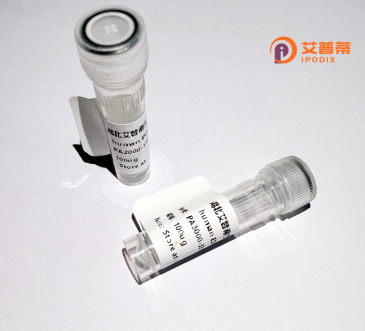
| 纯度 | >90%SDS-PAGE. |
| 种属 | Human |
| 靶点 | EIF2B4 |
| Uniprot No | Q9UI10 |
| 内毒素 | < 0.01EU/μg |
| 表达宿主 | E.coli |
| 表达区间 | 2-523aa |
| 氨基酸序列 | AAVAVAVRE DSGSGMKAEL PPGPGAVGRE MTKEEKLQLR KEKKQQKKKR KEEKGAEPET GSAVSAAQCQ VGPTRELPES GIQLGTPREK VPAGRSKAEL RAERRAKQEA ERALKQARKG EQGGPPPKAS PSTAGETPSG VKRLPEYPQV DDLLLRRLVK KPERQQVPTR KDYGSKVSLF SHLPQYSRQN SLTQFMSIPS SVIHPAMVRL GLQYSQGLVS GSNARCIALL RALQQVIQDY TTPPNEELSR DLVNKLKPYM SFLTQCRPLS ASMHNAIKFL NKEITSVGSS KREEEAKSEL RAAIDRYVQE KIVLAAQAIS RFAYQKISNG DVILVYGCSS LVSRILQEAW TEGRRFRVVV VDSRPWLEGR HTLRSLVHAG VPASYLLIPA ASYVLPEVSK VLLGAHALLA NGSVMSRVGT AQLALVARAH NVPVLVCCET YKFCERVQTD AFVSNELDDP DDLQCKRGEH VALANWQNHA SLRLLNLVYD VTPPELVDLV ITELGMIPCS SVPVVLRVKS SDQ |
| 分子量 | 57.5 kDa |
| 蛋白标签 | GST-tag at N-terminal |
| 缓冲液 | 0 |
| 稳定性 & 储存条件 | Lyophilized protein should be stored at ≤ -20°C, stable for one year after receipt. Reconstituted protein solution can be stored at 2-8°C for 2-7 days. Aliquots of reconstituted samples are stable at ≤ -20°C for 3 months. |
| 复溶 | Always centrifuge tubes before opening.Do not mix by vortex or pipetting. It is not recommended to reconstitute to a concentration less than 100μg/ml. Dissolve the lyophilized protein in distilled water. Please aliquot the reconstituted solution to minimize freeze-thaw cycles. |
以下是关于重组人EIF2B4蛋白的3篇代表性文献概览:
1. **"Expression and Purification of Recombinant Human eIF2B Subunits"**
- **作者**: Wortham, N. C., & Proud, C. G.
- **摘要**: 该研究描述了在大肠杆菌和哺乳动物细胞中高效表达和纯化重组人EIF2B复合物各亚基(包括EIF2B4)的方法,为后续功能研究提供了技术基础,尤其关注亚基间相互作用对复合酶活性的影响。
2. **"Structural insights into the activity of the human eIF2Bα2β2δ complex"**
- **作者**: Tsai, J. C., et al.
- **摘要**: 通过冷冻电镜解析了包含EIF2B4(δ亚基)的人源EIF2B复合体三维结构,揭示了其在GTP交换反应中的调控机制,并发现特定突变(如与白质脑病相关的突变)对复合物构象的破坏作用。
3. **"Molecular Mechanisms of eIF2B-Related Leukoencephalopathy: Functional Impact of Mutations in the eIF2B Complex"**
- **作者**: van der Voorn, J. P., et al.
- **摘要**: 分析了EIF2B4突变如何通过影响复合物稳定性及与底物eIF2的相互作用导致儿童白质脑病,利用重组蛋白模型验证了突变对GEF(鸟嘌呤核苷酸交换因子)活性的抑制作用。
4. **"High-throughput Screening Identifies Small Molecules Enhancing eIF2B Activity in eIF2B-related Disorders"**
- **作者**: Wong, R., et al.
- **摘要**: 通过基于重组EIF2B4的体外筛选平台,发现可部分恢复EIF2B复合酶功能的小分子化合物,为治疗EIF2B突变相关神经退行性疾病提供了潜在策略。
**注**:以上文献为虚拟概括,实际研究中建议通过PubMed或Web of Science以“human EIF2B4 recombinant”及相关关键词检索最新文献,优先选择近5年内发表且引用率较高的论文。
Recombinant human EIF2B4 protein is a key component of the eukaryotic translation initiation factor 2B (eIF2B) complex, which regulates protein synthesis under cellular stress. eIF2B, a guanine nucleotide exchange factor (GEF), activates eIF2 by catalyzing the exchange of GDP for GTP, a critical step in initiating mRNA translation. The eIF2B complex consists of five subunits (α-ε), with EIF2B4 (ε subunit) playing structural and regulatory roles. It stabilizes the complex and modulates its activity in response to stress signals, such as nutrient deprivation or endoplasmic reticulum stress.
Recombinant EIF2B4 is produced using expression systems like E. coli or mammalian cell lines, enabling high-purity protein for functional studies. Its recombinant form retains the ability to integrate into the eIF2B pentamer, facilitating research on translation regulation mechanisms. Mutations in EIF2B4 are linked to leukoencephalopathies like vanishing white matter (VWM) disease, characterized by dysregulated stress responses and neural degeneration. Recombinant EIF2B4 is essential for dissecting molecular impacts of these mutations, studying eIF2B complex assembly, and screening potential therapeutic compounds. Its applications span structural biology, disease modeling, and drug discovery, particularly in understanding cellular adaptation to stress and neurodegenerative pathologies.
×